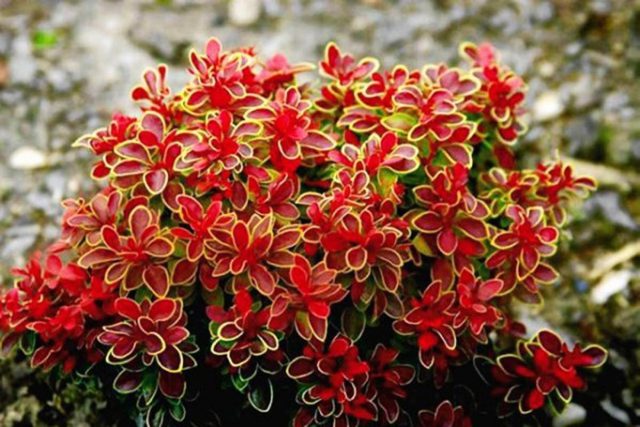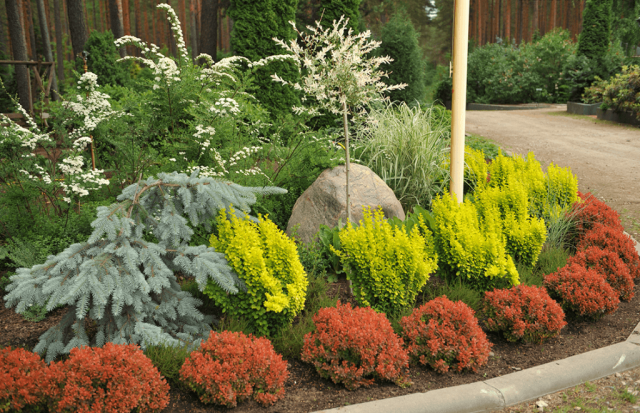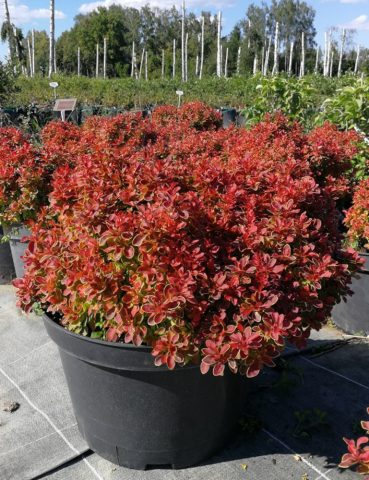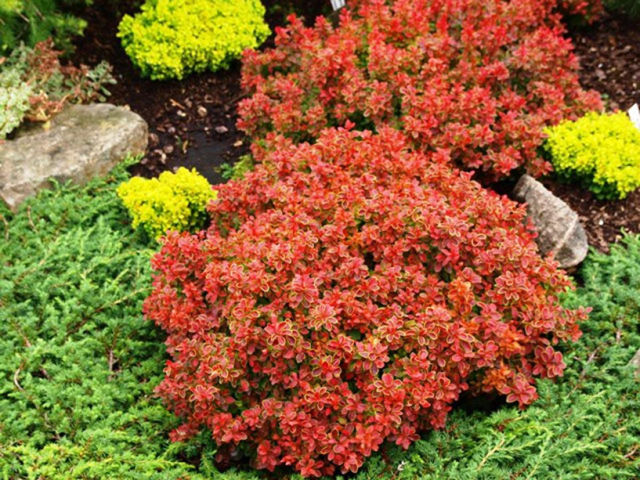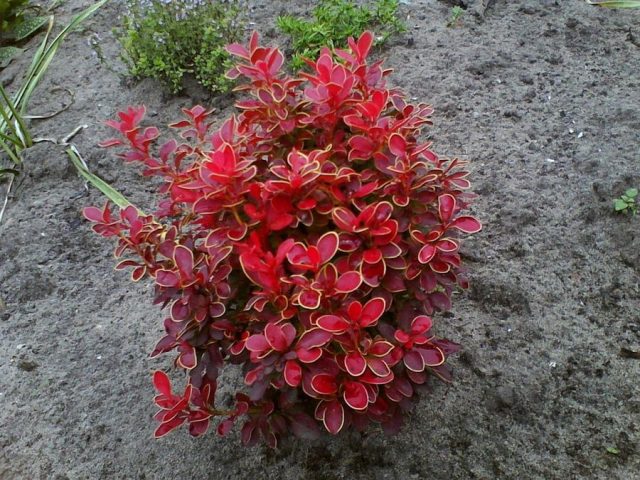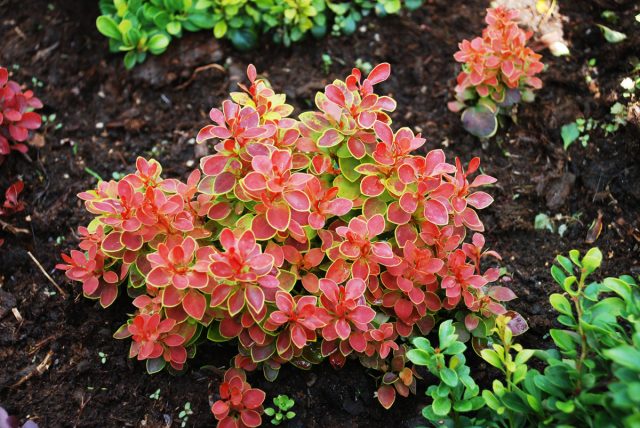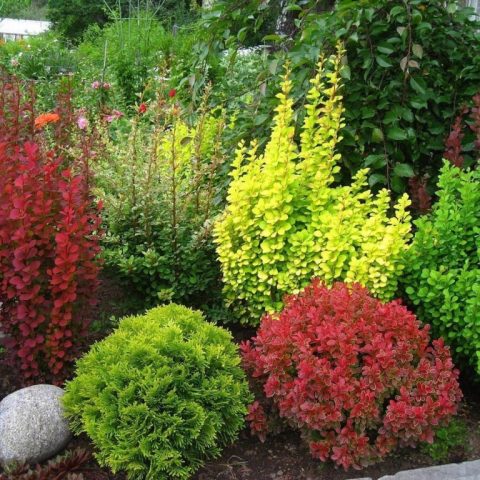Content
Barberry Admiration is a variety of the Thunberg barberry species that can decorate any space. Translated from English, Admiration means admiration, delight. These are the emotions that a variety of barberry with that name evokes. Despite the refined, aristocratic appearance, plant care is quite simple. It is equally easy to propagate barberry Admiration yourself.
Description of Barberry Admiration
Barberry Thunberg Admiration is very beautiful and decorative according to the description. It is a low-growing shrub, not exceeding 60 cm in height and 1 m in diameter. At a young age, the crown of the barberry has a spherical shape, subsequently the bush expands and resembles a round pillow in shape. The shoots of the variety are short, brown in color, with small needles.
The leaves are small, differ in their original shade - bright coral with a yellow border, from a distance they seem just purple. The intensity of foliage coloration varies depending on the season and growing conditions. With the onset of the autumn cold, the foliage acquires brighter colors. Barberry Admiration begins to bloom in May. The entire bush is covered with small flowers of a pale pink hue, which are collected in inflorescences of 3-5 pieces. In autumn, they are replaced by red berries that taste bitter. They are not unsuitable for food, but they give the bush a decorative effect.
Barberry Administration in landscape design
Thanks to its attractive appearance throughout the season, the Thunberg Admiration barberry is versatile in use in landscape design. It is equally well suited for growing in small gardens and on city streets and parks.
Other qualities contribute to this:
- compact size, low height of the Admiration barberry, suggesting placement in mixborders, rocky gardens, alpine slides;
- dense, almost impenetrable crown, allowing the organization of hedges, borders;
- original color of leaves of barberry Admiration, setting off monochromatic plantings and allowing you to create monochrome flower beds.
Planting and caring for barberry Thunberg Admiration
You can plant a plant without thinking about its preferences for soil and location, and then wait a long time (and as a result do not wait) for the properties declared by the variety. Any gardener sooner or later comes to the understanding that for every plant, even the most unpretentious, it is important to fulfill the necessary set of growing conditions.
Barberry Thunberg Admiration will show all the beauty of foliage if you plant it in an area open to the sun. Frost resistance allows you to grow a crop in the climatic conditions of the Central Russian region and some northern regions. The variety is undemanding to the soil, but there are certain preferences.
Seedling and planting plot preparation
Seedlings of the Admiration variety with a closed root system are planted at any time, from spring to autumn. Plants grown in containers have a healthy, well-developed root system and therefore take root better.
It is advisable to plant seedlings of barbars Admiration with open roots immediately after purchase. The purchase of such plants should occur before the start of sap flow (before bud break) or after it ends (after leaf fall).
Barberry Admiration prefers well-drained, light soils with neutral acidity. Tolerates some soil salinity. The Admiration variety develops better if the soil in which it is planted consists of sand, humus and turf in a ratio of 1: 1: 2.
It grows slowly in acidic soil and does not set fruit. Therefore, the acidic soil must be prepared for planting seedlings by liming. This can be done with slaked lime at the rate of 350 g per plant or wood ash at 250 g per bush.
Planting rules for barberry Admiration
To grow a beautiful barberry bush Thunberg Admiration as in the photo, experienced gardeners have developed certain rules:
- Plant the culture in open sunny areas or partial shade. From a lack of light, the leaves lose their color, the shoots are unevenly stretched, the appearance loses its attractiveness.
- For single plantings, the distance between the seedlings should be 1.5-2 m. A free-growing green hedge should be laid at the rate of 2 seedlings per 1 m. When planting a dense single-row green hedge, place 4 bushes per 1 m, two-row - 5 bushes per 1 m.
- The size of the pit for planting should exceed the size of the roots. It is more convenient to dig a trench for planting a hedge.
- For saplings of barberry of the Admiration variety with an open root system, straighten the roots before planting.
- To improve air access to the roots, fill the bottom of the pit with drainage (sand, expanded clay, broken brick).
- Place the plant in the hole and cover with fertile soil. Better to plant shallowly to stimulate new roots and new shoots.
- Water the sapling of barberry Admiration, and compact the soil around the plant. For the rooting period, the seedling is watered once every 10 days.
- To preserve moisture, the trunk circle is covered with mulch, which can be used as humus, foliage, compost or any organic matter.
- Shorten the shoots, leaving 3-5 buds to make it easier for the plant to take root.
Watering and feeding
Watering barberry Admiration in the first years of life is necessary as the top layer of the earth dries up. Subsequently, the shrub needs moderate watering, which is carried out at the root with warm water.
Water in 2-3 doses, soaking the soil deep enough. This southern heat-loving plant does not tolerate excess moisture even in extreme heat. Barberry Admiration is more likely to survive in arid conditions than in soil with stagnant water.
In the first year of cultivation, it is not necessary to fertilize the barberry, the land is sufficiently fertilized before planting. Next spring, it is important to feed the Admiration shrub with nitrogen fertilizers, for example, urea (20-30 g per 10 liters of water). Then fertilizers are applied once every 4 years:
- in the spring - nitrogen;
- in the fall - phosphorus and potash.
Loosening and mulching
Barberry bush Admiration will develop well if the soil around the bush is regularly loosened, combined with weeding. Mulching will help reduce the amount of loosening. Vegetable mulch serves as an additional organic fertilizer for the plant.
Pruning
Barberry Admiration is a slow-growing plant, adding 10-20 cm per season. Nevertheless, pruning the bushes is a must-have in care. It improves the appearance of plants and helps prevent disease. The need for pruning occurs at least 2 times a year:
- in the spring - sanitary, when frozen, broken, thickening shoots, as well as branches located close to the soil surface are removed;
- in summer - forming, giving the bush certain shapes.
Pruning barberry in a green hedge should be done in the 2nd year of growth, cutting off half of the green mass. In subsequent years, pruning is carried out 2 times a year, in early June and August.
Preparing for winter
Barberry Admiration belongs to frost-resistant crops and is able to survive frost up to -35 ° C, but it is better to cover young plantings for the winter with coniferous branches or leaf litter.
Reproduction of barberry Admiration
Barberry Thunberg Admiration can be propagated in several ways:
- sowing seeds,
- cuttings,
- layering,
- dividing the bush.
Each method has its own advantages.More often, gardeners use the method of sowing by seeds and cuttings.
For seed propagation, you should adhere to the following algorithm:
- In autumn, you need to collect ripe berries of the Admiration barberry, separate the grains from the pulp, process in a 1% solution of potassium permanganate and dry.
- Sow seeds to a depth of 2-3 cm, on a specially prepared bed with loose fertile soil. This must be done 2 weeks before the first frost.
- Thin seedlings in spring, giving preference to stronger specimens.
- Young plants can be transferred to the chosen place in the second year after sowing.
- Sowing can be done in spring, but the seeds should be stratified for 3 months (kept in wet sand at a temperature of 0-4 ° C).
In the 2-3rd year of growth, young bushes will give the first berries.
Propagating barberry Administration by cuttings is also not difficult, for this you need a greenhouse or greenhouse.
- Cuttings suitable for reproduction are harvested in June. A favorable time for harvesting is the morning hours before the onset of heat.
- Leaves from the cuttings should be removed all except those on the crown, shortening them in half.
- The cuttings are soaked in a root-forming solution.
- Cuttings are planted in a greenhouse, in moist soil. For the first 14 days, it is necessary to maintain soil moisture, ventilate the greenhouse.
- As soon as new young leaves appear, the seedlings gradually begin to harden. The soil is kept loose.
- The grown plants are planted in a permanent place after 2 years.
An effective way to propagate barberry is by layering.
- Choose annual young shoots.
- Make a recess 10-15 cm deep under the selected layering, into which to lay the shoot and secure with a hairpin.
- Sprinkle the deepening with earth and moisten. The end of the escape should be peeking out above the ground.
By the end of the season, a seedling with a ready-made root system is obtained in this way. The method is good because over the summer many layers are obtained from one bush.
Barberry bushes Admiration at the age of 3-5 years can be propagated by division.
- The bush must be dug out completely. This should be done in early spring, as soon as the earth can be dug.
- Mark the places for dividing the bush, hoping that each part will get a sufficient number of large roots. If it is impossible to separate the bush by hand, then a saw is used.
- Sections should be treated with 1% potassium permanganate solution or sprinkled with charcoal.
- Plant parts of the bush immediately in permanent places.
Diseases and pests
Colonies of barberry aphids are capable of completely destroying the plant. The leaves from the vital activity of aphids are deformed, dry up and fall off. The flower buds responsible for the next year's harvest are not laid, the shoots are bent.
Methods of struggle - spraying barberry with soap solution (250 g of green soap per 10 liters of water) or infusion of tobacco dust (0.5 kg of the product per 10 liters of water with the addition of green soap).
The flower moth is a threat to the fruit of the barberry. Methods of dealing with it - treatment with chlorophos, fufanon or decis according to the instructions.
In addition to insect pests, fungal diseases pose a health hazard to barberry.
Powdery mildew is accompanied by a white bloom on all aerial parts of plants. Leaves and young shoots gradually dry out.
Control methods: spraying with sulfur-containing preparations, the first time before swelling of the kidneys, then every 2-3 weeks. Diseased shoots and leaves should be cut and burned.
Leaf spot appears on leaves with spots of different size and color. The leaves suddenly dry up and crumble. Infected shoots do not tolerate winter well. Bushes lose their decorative effect.
Control methods - two-time treatment of plants with copper-containing preparations, before and after flowering.
The withering of the barberry is manifested by the drying out of part of the branches of the bush, and the whole bush gradually dries up. On the cut of the shoots, darkened vessels are visible. In order to avoid further infection, the affected branches should be pruned and burned.
Conclusion
Barberry Administration was launched only 50 years ago, but quickly gained popularity. It attracts gardeners with the beauty of the shrub throughout the season, the ease of reproduction and cultivation under simple conditions.
